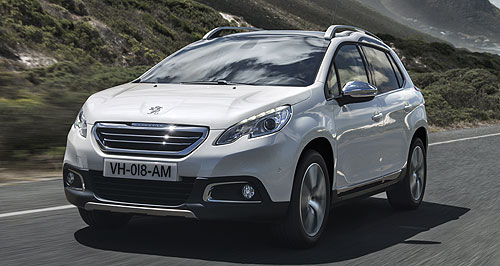Future models - Peugeot - 2008Peugeot goes global with 2008Global Pug: The Peugeot 2008 sub-compact crossover has been developed with the booming Brazilian and Chinese markets in mind, but will launch in Australia later this year. Rushed to market, Peugeot 2008 crossover has true global focus29 Apr 2013 By BYRON MATHIOUDAKIS in FRANCE THE CRUCIAL new 2008 crossover has been rushed into production, as Peugeot scrambles to gain traction in markets outside of its traditional European comfort zone. On sale in Australia from October, the 208-based sub-compact SUV met its development targets more than a month ahead of schedule, enabling the brand to launch the vehicle sooner in growth countries such as Brazil and China. The newcomer cannot come soon enough for Peugeot, with the embattled 125-year old car-maker posting a record loss of €5bn ($A6.3bn) in 2012, amid continuing falling share in economically depressed Europe. Lingering problems in the company’s historically robust markets of France, Spain, and Italy are stifling recovery attempts, despite a promising start for the 208 city car. In the 12 months since April 2012, it has posted over 300,000 sales. Peugeot expects that by 2015, with full production underway in Brazil and China as well as in Mulhouse, France, about 200,000 2008s are scheduled to be made annually, giving the firm a much-needed boost. According to program manager Agnes Tesson Faget, the new crossover will be Peugeot’s most widely available vehicle on the planet, sold in over 180 markets worldwide. “To show you how important this car is for us worldwide we plan to sell up to 200,000 units a year maximum,” she told GoAuto in March, adding that – along with France – China and Brazil are key market targets for the 2008. “This is the first car to be truly international from the start. From the start we knew we would produce this everywhere we had factories. “This type of crossover is now very much expected all around the world. Maybe sometimes for different reasons too – some expect something modern, something trendy, and something very useful that can be driven any place. So we are very much in tune with the expectations of those customers. “Australian-market production is scheduled for July. It is very important for us to come to market as quickly as possible around the world with this vehicle. It is really international from the start.”Planning for the €400 million ($A5.06m) mini crossover started in 2009, with development commencing in February 2010. With some 400 people working on the project, the design had been frozen by September of that year, with the first prototypes hitting the road by May 2012. To speed things up, the 2008’s gestation ran concurrently with the 208, and the two vehicles share around 70 per cent of their parts. These include the transverse front-wheel drive layout, MacPherson strut front suspension, torsion beam rear end, 1.2-litre three-cylinder engine, and 1.6-litre four-cylinder powerplants – the latter available in diesel as well as petrol configurations. Turbo versions of both petrol units will follow later on, bringing six-speed automatic transmission availability for the first time. Currently the only auto on offer is an outmoded four-speeder on the 1.6 petrol. Stylistically the 2008 is a collaboration between Peugeot’s French, Brazilian, and Chinese studios, with the “best parts” of several proposals incorporated into the final design in Paris, according to Ms Tesson Faget. “From the start the various design teams competed within the brand,” she said. “So in this respect it is very much an international focus from the beginning.”Since the 2008 is a 208 offshoot, it benefits from that car’s use of very-high and ultra-high strength steels, short overhangs and tailored body blanks, which resulted in falls of up to 173kg compared to the preceding 207. “All the weight loss measures gained on the 208 were transferred to the 2008, so it makes the 2008 very efficient (for its class),” Ms Tesson Faget added. As a result, the 2008 is around 65kg heavier than the corresponding 208 model, with the kerb weight kicking off from a class-leading 1045kg. A thorough development regime included snow and mud environments, as well as hot-weather desert climates, reflecting the vehicle’s global ambitions. “This is definitely the most modern Peugeot today,” Ms Tesson Faget believes. “But we also wanted it to be very convenient, roomy, versatile, comfortable, practical, stylish and a pleasure to drive.”Along with luring buyers away from the Nissan Juke, Ford EcoSport, Opel Mokka, Holden Trax, and Renault Captur, the 2008 will also serve as an alternative to the slow-selling 207 SW station wagon, which will not be replaced.  Read more22nd of April 2013  First drive: Peugeot gets it right with 2008Peugeot’s baby 2008 crossover has the smarts to shine despite drivetrain shortfalls1st of March 2013  Geneva show: More details on Peugeot 2008 crossoverHigh-riding, Juke-rivalling Peugeot 2008 revealed in full ahead of Geneva debut8th of January 2013  Geneva show: Peugeot reveals production 2008First proper look at Peugeot’s answer to the Nissan Juke as the 2008 is uncovered19th of September 2012  First drive: Peugeot Australia launches bold 208Impressive infotainment system headlines Peugeot's chic 208, priced from $18,490 |
Click to sharePeugeot modelsResearch Peugeot Motor industry news |


































Facebook Twitter Instagram